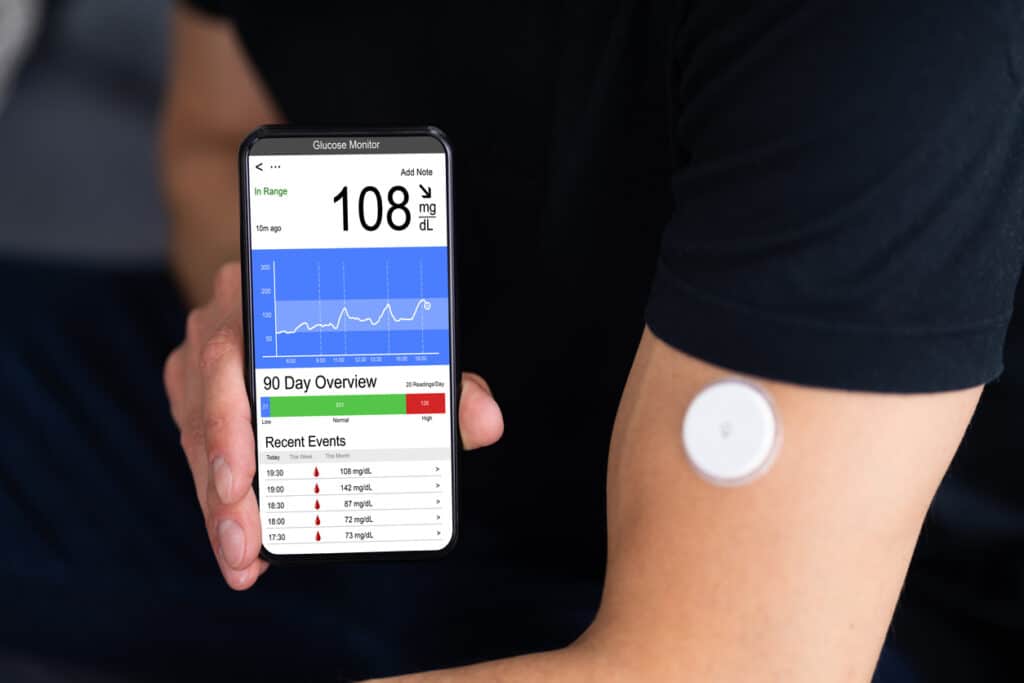The Hype, The Science, and What Healthy People Should Know About CGMs.
Why CGMs Took Off in the “Wellness” World
Continuous glucose monitors (CGMs) have exploded in popularity thanks to influencers, wellness startups, and biohacking apps. CGMs for non-diabetics are often marketed as the next-gen Fitbit for your metabolism—claiming to unlock personalized nutrition, fat-burning potential, and real-time feedback to optimize your diet.
But here’s the thing: CGMs were developed for people with diabetes, where tracking blood sugar is literally life-saving. If you don’t have diabetes, does slapping one on your arm offer any real benefits—or just more data than you need?
What “Normal” Blood Glucose Actually Looks Like
Normal fasting glucose levels range between 3.9-5.6 mmol/L or 70-100 mg/dL. After meals, reaching 7.8 mmol/L (140 mg/dL) is normal, as your body releases insulin to shuttle the glucose into the cells. 2 hours after eating, blood glucose should be down to under 7.8 mmol/L or 140 mg/dL

A massive study called CGMap (n > 7,000 healthy adults aged 40–70) gave a detailed look at typical glucose levels in people without diabetes:
- Average 24-hour glucose: ~5.5 mmol/L (99 mg/dL)
- Time spent ≥7.8 mmol/L (140 mg/dL): less than 3% of the day (about 20 minutes)
- Overnight lows <3.9 mmol/L (70 mg/dL): rare
So yes—glucose spikes do happen, especially after eating. But these are normal and expected. In people with healthy metabolic function, your pancreas quickly clears that sugar and brings your levels back to baseline.
No human trial has shown that these short-lived spikes in healthy people are harmful, or that they increase the risk for disease.
Do CGMs Change Health Behaviours in Healthy People?
Let’s break down what recent human trials have discovered.
🍽️ CGMs Don’t Change Diets Much
In a 2022 crossover study (PMID: 36279286), 15 healthy adults ate two isocaloric diets—one high in refined carbs, one high in fiber—while wearing CGMs. Though the devices clearly detected higher spikes with the refined-carb meals, this didn’t lead to long-term dietary changes.
🏃 Exercise Doesn’t Shift Glucose in the Way You Might Expect
In a 2023 Canadian study (PMID: 37562361), 27 sedentary adults wore CGMs while doing 11 minutes of daily vigorous calisthenics vs. sitting. The intervention group got fitter, but their glucose didn’t budge—mean glucose and glycemic variability remained unchanged.
🕐 TRE (Time-Restricted Eating) + CGMs = Minor Changes
A 2023 RCT (PMID: 37527388) studied overweight adults without diabetes. Participants did time-restricted eating (eating 7am–3pm) with a calorie deficit, compared to a calorie deficit alone.
- The TRE group had slightly smaller glucose spikes (~0.3 mmol/L lower),
- But no change in weight loss or mean glucose.
🧠 Most People Misinterpret CGM Data
In a 2023 survey of non-diabetic CGM users (PMID: 37470511), most people said they checked the data frequently—but few understood it. Some even eliminated healthy carbs unnecessarily.
“CGM use outside of a clinical setting may lead to inappropriate dietary restrictions and increased food anxiety.” — Study authors
Bottom line: CGMs aren’t driving better outcomes in people who are already metabolically healthy. They may even backfire.
Are Post-Meal Glucose Spikes Harmful?
No, and here’s why:
- After you eat carbs, glucose naturally rises.
- Your pancreas releases insulin, which clears the sugar into your muscles and liver.
- This entire process is normal, temporary, and not harmful in healthy people.
The spike is part of the system working correctly, not failing.
Studies in healthy people show that brief post-meal glucose elevations (e.g. 120–140 mg/dL for an hour) are not associated with inflammation, oxidative stress, or long-term metabolic damage. Attempts to flatten these small rises often lead to extreme food avoidance or anxiety—not better health.
The Case Against Wearing a CGM Without Diabetes
| Concern | What the Science Shows |
|---|---|
| Medicalizing normal biology | 97% of CGM readings in healthy people fall within range (CGMap data). Normal spikes don’t need “fixing.” |
| Inaccuracy | Even newer CGMs (like Dexcom G7 and Libre 3) show 9–14% error rates compared to lab glucose in healthy people. |
| Skin reactions | Adhesives can cause rashes or allergic reactions (PMID: 31794494). |
| Data obsession | People often become overly focused on individual readings. This can fuel anxiety or orthorexia-like behaviors. |
CGMs For Non-Diabetics – Can They Help?
Possibly—but only in very specific cases:
- Pre-diabetes screening in high-risk individuals (family history, PCOS, obesity)
- Elite athletic performance, where precise fueling might affect endurance
- Clinical research settings studying metabolic function
But for most people, lifestyle factors (diet, sleep, exercise, stress) give you more impact than micromanaging your glucose minute-by-minute.
Conclusion: You Probably Don’t Need a CGM
If you don’t have diabetes or a diagnosed blood sugar disorder:
✅ Your body handles glucose regulation on its own
✅ Small spikes after eating are normal and harmless
❌ CGMs don’t meaningfully improve health outcomes in healthy people
❌ You might end up overcorrecting, over-restricting, or stressing out
Save your money—and spend it on fiber-rich foods, movement you enjoy, and good sleep hygiene. The simple stuff still works best.

